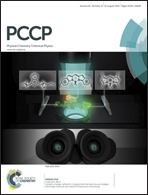An anatomy of intramolecular atomic interactions in halogen-substituted trinitromethanes
Abstract
The intramolecular interactions in substituted trinitromethanes, XC(NO2)3 (X = F, Cl, I, H) are studied and clarified by using a combination of the Quantum Theory of Atoms in Molecules (QTAIM), the non-covalent interaction analysis and the Interacting Quantum Atoms (IQA) methods. The stretching vibration modes are formed by the concerted displacements of atoms involved in the covalent bonds showing the significant multiatomic influence in substituted trinitromethanes. In agreement with that, the arrangement of the local reduced density gradient minima indicates that the electron density favors the non-covalent intramolecular interactions X⋯O and N⋯O. However, the corresponding QTAIM bond paths are not formed; instead, contacts, which we call uncompleted links in this context, are accompanied by “quasi-bonding channels” corresponding to the λ2(r) ≤ 0 regions on the sign[λ2(r)]ρ(r) contour maps. The intramolecular IQA energy contributions signal the appreciable electron exchange between the pairs of atoms associated with potential atomic interactions or the bond-path-free non-covalent links. The IQA analysis shows that the electrostatic term destabilizes FC(NO2)3 and distinctly stabilizes IC(NO2)3, whereas it is close to neutral in ClC(NO2)3. The exchange energy between the X atom and the NO2 groups, in contrast, stabilizes all the molecules.


 Please wait while we load your content...
Please wait while we load your content...